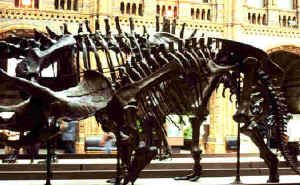BACKGROUND:
Museums are a wonderful resource for students of all ages. For those
interested in dinosaurs, they are especially exciting. Where else can you
experience the thrill of seeing, smelling, perhaps even touching a dinosaur
skeleton that is tens or hundreds of millions of years old? There is no
substitute for the sense of awe and connection with the past that you feel
when standing at the foot of a Tyrannosaurus or Apatosaurus
skeleton.
 We encourage you to organize a trip to your local natural history
museum for this post lab. Keep in mind that colleges and universities may
have their own paleontology museums or fossil displays that would be fun to
visit. Fossils aren't only found in natural history museums!
We encourage you to organize a trip to your local natural history
museum for this post lab. Keep in mind that colleges and universities may
have their own paleontology museums or fossil displays that would be fun to
visit. Fossils aren't only found in natural history museums!
If a field trip isn't possible, we suggest one of the following
alternatives. In this Age of Technology, natural history museums come in two
forms: actual and virtual. Most of us have visited an actual museum, but
fewer are familiar with the "virtual museum." Virtual museums are
electronic displays of museum exhibits and information on the Internet. They
are produced by actual natural history museums and are available for viewing
on computers connected to the Internet. A virtual museum field trip doesn't
quite provide the excitement of a real museum excursion, but it's cheaper,
quicker, and can be thrilling in its own way. If you have Internet access,
we suggest you try this option. The electronic addresses of our favorite
museum sites are listed below. You may visit these sites to view general
dinosaur exhibits or to find out more information about a specific type of
dinosaur.
PROCEDURE:
- Read Digging Up Dinosaurs to your class.
- Have the class make a list on the board of the steps that
paleontologists go through to bring dinosaur bones from being buried in
the ground to being a museum display. A sample list is given below
- Discover bones in/on ground and/or in rocks.
- Excavate (dig up) bones and take them to a museum.
- Clean rock and dirt from bones.
- Glue any broken pieces of bone back together.
- Mount (make a skeleton from individual) bones using strong
metal supports.
- Fill-in any missing bones with plaster or fiberglass casts
- Take the class on a field trip to your local natural history museum,
or use the internet to visit one of the virtual museum sites listed
below
Royal Tyrell Museum (Canada): Dinosaur Hall
http://www.tyrrellmuseum.com/
- You may want to work with the class to make a list of facilities in
your area that have dinosaur displays. This research will require a
local telephone book and newspapers. Leave the finished list with name,
address and phone number of each institution up in the classroom so that
children and parents may make use of it.